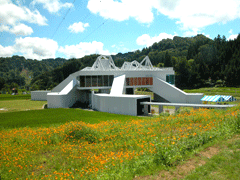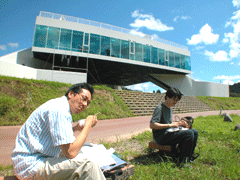 --
--
(photos: Sotaro Yamamoto)
--On a fine summer day, in a green expanse of rice fields, a uniquely shaped
white object appears amidst a background of low hills. It is the public
facility called Matsudai Snow-land Agrarian Culture Centre, the first Japanese
project designed by the Netherlands based architectural unit MVRDV. The
project has been in preparation for the past three years, in anticipation
of the second "Echigo-Tsumari Art Triennial" held here this summer.
--Echigo is located in Niigata Prefecture, in a mountainous region of central Japan. While modern Japan is best known for its huge urban centers, Echigo has a low population, and its natural beauty remains; Niigata Prefecture itself is quite famous in Japan for its rice production. Despite this, Echigo and other rural areas in Japan are becoming more and more depopulated as its younger residents move to the metropolises. To attract more visitors to this farming district, 140 artists from 32 different countries (2000 Triennial) and 157 artists from 23 countries (2003 Triennial) were invited to create installations that would activate the region. Among these are some architectural projects. The artist James Turrell, the Japanese architect Yoshiharu Tsukamoto, and other architects designed short-term accommodation facilities for the 2000 Triennial. This year, in addition to MVRDV, Hiroshi Hara (Japan), Peripheriques (France) and Tezuka Architects (Japan) contributed projects. These facilities are expected to form a base for the continued cultural expansion of the region.
--MVRDV's building is designed to introduce the agriculture of this area, and includes exhibition, event and dining facilities. Various spaces were created through the collaboration of 6 different artists; their work was brought to a square shaped exhibition floor; and the resulting volume was boldly lifted into the air, supported by six staircases. The bold formal idea was inspired by the region's climate. In the Echigo wintertime, snow typically accumulates to a height of several meters. The six steel stairs legs that would normally splay outwards under this loading are held in tension underground, maintaining equilibrium. The triangulated steel frames on the roof floor are not just expressive objects, but the stair frames penetrating the roof and suspending the building from above.
--It seems that MVRDV's design process started with a careful research of the site conditions; they then ordered these conditions into a daring physical form that radically challenges the building program. MVRDV's own computer graphic slide presentation of the design process was quite telling. Firstly, they fit the essential program functions into a compact volume. Then, they superimposed three circulation paths through this volume; and finally, they lifted this volume to create an event space underneath. Usually, during the planning process, architects proceed through a trial and error process as conditions change or new ideas generated. MVRDV's process was quite different. Each condition was addressed in order, and it seemed that the planning proceeded linearly, almost automatically. It was a very pleasing process; the computer graphic images themselves seem to have been realized. Therefore, the building is filled with the sense of virtual, an enlarged image of the computer drawings. This lack of reality is, taken positively, critically compelling for its originality; simultaneously (taken negatively), it can be seen as easy-going.
--Though relatively simple in concept, the realization of this project was quite complex. MVRDV did the preliminary design, while SUPER-OS and CLIP (Japanese architectural offices) assisted the preliminary design, did working drawings and supervision, and worked with the structural engineer in a search for unique ideas. The client was this region's local government body, the coordinator was the Triennial planner, and a variety of requests came from local residents as well. Beyond this, there was also the participation of a variety of artists from around the world. The rural location made the collaboration between the Netherlands and Japan even more difficult.
--Looking at the building, it is difficult to judge who did what. Despite the many collaborators and resulting complexity in communication, it is obvious that the clear overall composition was designed by MVRDV. As mentioned at the beginning of this article, this facility is often introduced as a building that floats in a fresh green field. It might be seen as an anomaly to the majority of MVRDV's works located in more urban settings. Is MVRDV's conceptual design process out of place in this peaceful, natural setting? In considering this question, one should remember that the rice fields surrounding the site result from much time and labor. In one sense they are natural, but simultaneously controlled and artificial - similar to the Netherlands, where much land is created artificially. One can conclude that this building site was very fitting for Dutch architects.
('de Architect', oktober 2003)